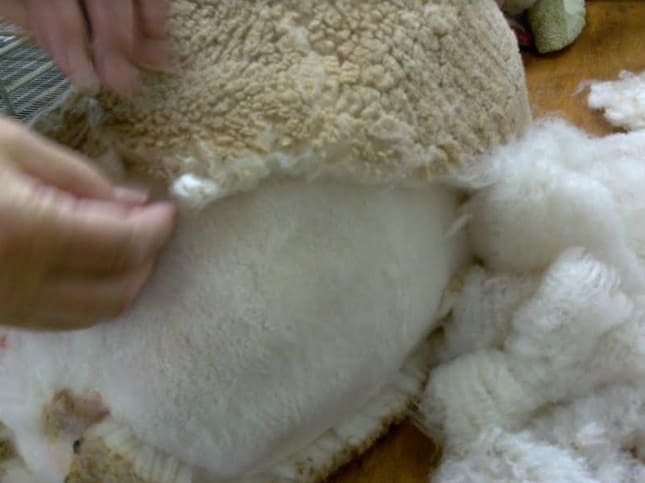
Wool being removed manually from a chemically defleeced sheep in an earlier study. Image – Phil Hynd.
AUSTRALIAN wool growers will not know how biological defleecing might be implemented for at least another 18 months.
And any need for regulator approval for chemicals or processes used could further extend the timeframe to on-farm readiness, according to Australian Wool Innovation chair Jock Laurie.
Mr Laurie today said work is progressing well on developing a new form of biological defleecing with a $1.4 million University of Adelaide project.
“It is critically important for the industry because we need to provide growers with options.
“Times of pressure in industries drive change and that is exactly where we are with the wool industry right now,” he said.
“We are seeing some very positive things coming out of the University of Adelaide’s work and they are confident that they can progress it and confident that in about in eighteen months’ time we should have a clearer picture of what the story is.”
Mr Laurie said defleecing technology creates a break in the wool staple with a tensile strength of 8-10 Newtons/kilotex, allows the fleece to grow to five millimetres under the break before removal.
Nets are not needed, but Mr Laurie said work is being done now on how to best administer the protein.
“We know that the protein puts a break in the wool so we can harvest it easily.
“It is amazing the number of wool growers who have got ideas on how to remove the wool so I think it will be a fairly simple process using VE machines, a level of robotics or air or whatever to remove the wool and move it via air up into bins, classers tables or wool presses,” he said.
“I think there is a whole lot of processes to consider.
“That’s what the evolution will be,” Mr Laurie said.
“Obviously, there will be a need for Australian Pesticides and Veterinary Medicines Authority approval, commercialisation to deal with and the need for mechanical means to remove the wool.”
Mr Laurie said it will be up to the industry’s grower bodies to impress upon the Federal Government the importance of progressing or fast-tracking approval processes. He said the University of Adelaide project is timely and has the potential to be a major change in wool harvesting.
“I think there will always be manual shearing, but this is about an investment that provides choice for the industry so that they can make decisions about how they want to process their wool.
“You have to be a real athlete to be a shearer and in a competitive market place it can be hard to draw them into the industry so we need to have other options,” he said.
“The industry will decide where this technology fits in term of what types of wool.
“It’s the same with all issues, we don’t tell woolgrowers what to do, you as a wool grower will have a look at your business and see if you are having an easy or tough time getting shearers, whether or not you want to update your shearing shed or whatever it is and then you can make up your mind. At AWI, we just provide the tools,” Mr Laurie said.
“At this stage, I can say it is very positive and I hope this gives confidence to the industry that we will continue to invest in this work, we’ll drive it, we have seen enough to see the potential in this development.
“The biological defleecing option may not be used by everyone, but it is another option to remove the wool safely.”



HAVE YOUR SAY